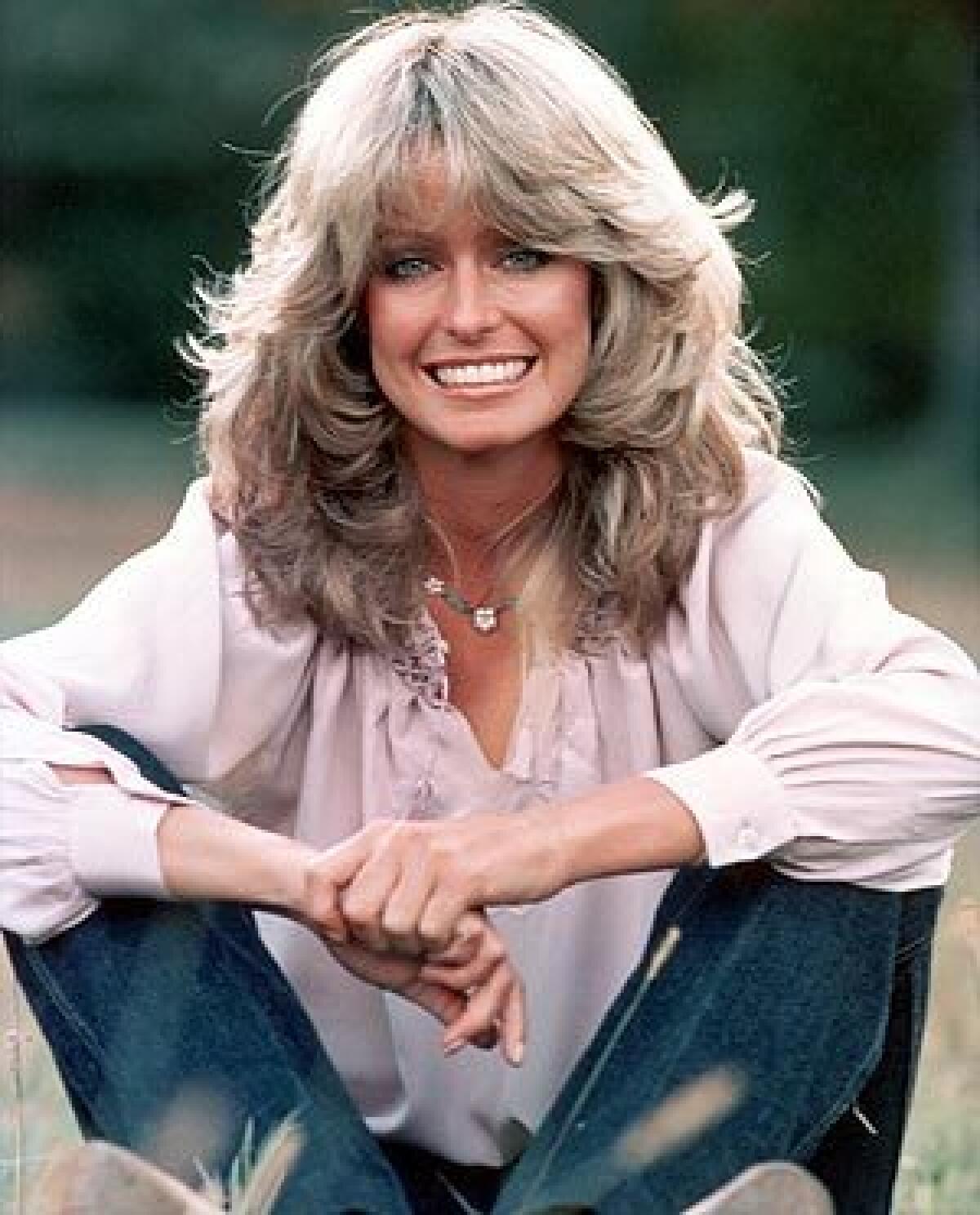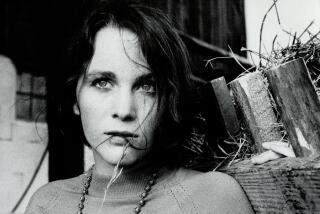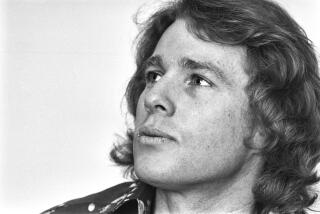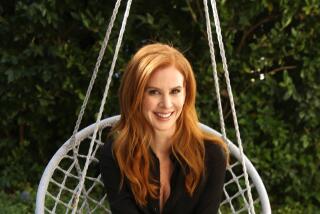Farrah Fawcett dies at 62; actress soared with, then went beyond, ‘Charlie’s Angels’

Farrah Fawcett, who soared to fame as a national sex symbol in the late 1970s on television’s campy “Charlie’s Angels” and in a swimsuit poster that showcased her feathery mane and made her a generation’s favorite pinup, died Thursday. She was 62.
Fawcett, whose celebrity overshadowed her ability as a serious actress, was diagnosed with a rare cancer in 2006. She died at St. John’s Health Center in Santa Monica, said Paul Bloch, her publicist.
Three months after she was declared cancer-free in 2007, doctors at UCLA Medical Center told her the cancer had returned and spread to her liver, and she repeatedly sought experimental treatment in Germany.
Actor Ryan O’Neal, her longtime companion, called her cancer fight “long and brave” and said her family and friends took comfort in “the knowledge that her life brought joy to so many people around the world.”
Kate Jackson called her “Charlie’s Angels” costar “an inspiration” who “showed immense courage and grace throughout her illness.”
“When I think of Farrah, I will remember her kindness, her cutting dry wit and, of course, her beautiful smile,” Jackson said in a statement.
Another “Charlie’s Angels” costar, Jaclyn Smith, said in a statement, “Farrah had courage, she had strength, and she had faith. And now she has peace as she rests with the real angels.”
As an actress, Fawcett was initially dismissed for her role as Jill Munroe in “Charlie’s Angels,” one of the “jiggle” series on ABC-TV in the late 1970s.
But she transformed her career and some popular perceptions in 1984 with “The Burning Bed,” a television movie about a battered wife that brought her the first of three Emmy nominations. She further established herself as an actress in the play and later feature film “Extremities,” about a rape victim who takes revenge on her attacker.
Robert Greenwald, who directed “The Burning Bed,” told The Times on Thursday, “She was incredibly gutsy, courageous and a risk-taker. She had this wonderful beauty, this very successful career and, unlike many people, she used it to open doors and take big chances.”
Yet for many, the poster of her wearing a wet, one-piece swimsuit and a blinding smile endured.
“If you were to list 10 images that are evocative of American pop culture, Farrah Fawcett would be one of them,” Robert Thompson, a professor of television and popular culture at Syracuse University, told The Times. “That poster became one of the defining images of the 1970s.”
Fawcett was part of a new generation of celebrities whose fame was fueled by heightened coverage of their ongoing personal dramas, Thompson said.
She had many: a failed marriage to actor Lee Majors; a stormy, long-term relationship with O’Neal; a son who fought drug addiction; a writer-director boyfriend, James Orr, who was convicted of assaulting her; a Playboy video that featured her using her naked body as a paintbrush; and a spacey 1997 appearance on David Letterman’s late-night TV show that caused critics to question her mental state.
For her part, Fawcett once said all she had to do to get on the cover of People was to “have a new boyfriend or even a new dog,” Texas Monthly reported in 1997.
At first, her mane nearly eclipsed her fame.
“Charlie’s Angels” showcased the long, feathered tresses that framed her face, launching a national fad of copycat haircuts. Many Fawcettphiles believed the hair had as much to do with the poster’s sales as anything, The Times reported in 1977.
Within six months, the poster sold five million copies, outstripping the records of such previous sex symbols as Betty Grable and Marilyn Monroe. It wound up selling a reported 12 million copies.
“You were a real man if you had her poster. She was our pinup girl,” Mike O’Meara, a radio show host who was in high school when it came out, told the Baltimore Sun in 2006.
Fawcett quit the series that brought her initial fame in 1977 after a single season, saying producers were preventing her from growing as an actress. With Jackson and Smith, Fawcett had played a private investigator whose main talent seemed to be the ability to wield a gun while going braless and shouting, “Freeze, turkey!”
“Charlie’s Angels” was so popular that 59% of the television audience tuned in, according to Time magazine, and the Los Angeles Times’ review of the series premiere pointed out why: The show dripped with sexuality and “good-natured but quite intentional teasing.”
Along with “Three’s Company” -- a double-entendre-filled ABC sitcom that debuted six months after “Charlie’s Angels” in fall 1976 -- the show is credited with helping to launch television’s “jiggle” era. Still, the show was seen as empowering women, even if they did take their orders from an unseen male boss named Charlie.
“In an odd way, even with all that Lycra and bralessness, the show was a feminist statement,” Thompson said. “This was an hourlong drama with women as action heroes. They were working in areas of power that generally we didn’t see women in much.”
Fawcett, who had appeared in shampoo ads, would triumph over critics who dismissed “Charlie’s Angels” as little more than a commercial for hair products. But first she appeared in two lightweight feature films: “Somebody Killed Her Husband” (1978) and “Sunburn” (1979).
She surprised critics with her intense portrayal of the battered wife who immolates her husband in the TV movie “The Burning Bed.” The 1984 Times review noted her “growing acting skill” and “deeply moving performance.”
The phrase “Burning Bed” entered Hollywood’s lexicon as shorthand for actresses who wanted to be taken seriously. “Managers would call and say, ‘She’d like to do her ‘Burning Bed,’ ” Greenwald, the film’s director, said Thursday.
The off-Broadway play “Extremities” provided another dramatically taxing showcase in 1983. Following Susan Sarandon in the starring role, Fawcett broke her wrist during a fight scene and lost weight because the part was so physically demanding. She also earned respectable reviews.
When the film of “Extremities” followed in 1986, The Times’ Charles Champlin called her performance “further declaration of her arrival as a serious and intelligent actress who happens to be beautiful.”
Robert Duvall cast Fawcett as his wife in his 1997 independent film “The Apostle,” about a Texas Pentecostal preacher who escapes to Louisiana after accidentally killing his wife’s lover. Again, she won praise.
“That woman’s work has been very underrated,” Duvall told Texas Monthly, citing her Emmy-nominated performance in “Small Sacrifices,” a 1989 TV movie in which her character kills her children. “That woman knows how to act.”
With O’Neal, with whom she had a son, she starred in “Good Sports,” a short-lived 1991 CBS sitcom that was her last network television series. She received her final Emmy nomination in 2003 for guest-starring on “The Guardian” on CBS.
Farrah Leni Fawcett was born Feb. 2, 1947, in Corpus Christi, Texas, to James Fawcett, who founded a pipeline construction company, and his wife, Pauline. Her older sister, Diane, died of lung cancer in 2001.
While studying painting and sculpture at the University of Texas at Austin, Fawcett was used to being judged by her looks. College men lined up to meet the freshman at her sorority in 1965, her college boyfriend told Texas Monthly. After she was voted one of the 10 most beautiful women on campus, a Hollywood publicist came calling.
Her parents wanted her to finish college before coming west, but they gave in after her junior year. Within two weeks of arriving, Fawcett had an agent and a significant other -- Majors, who had arranged an introduction after seeing her photograph, she often said. She signed a contract with Screen Gems, Columbia’s television subsidiary, and got bit parts on shows such as “The Flying Nun” and “The Partridge Family.”
Majors married Fawcett in 1973 and became “The Six Million Dollar Man” on ABC a year later. She sometimes appeared on the series.
Her contract for “Charlie’s Angels” stipulated that she had to be home every night by 6:30 to make Majors’ dinner at their Bel-Air home, but the domesticity didn’t last. While on location in 1979, Majors arranged for his dashing buddy O’Neal to look in on Fawcett. By fall, she had moved into O’Neal’s Malibu beachfront home, Time magazine reported in 1997.
They had a tumultuous relationship that lasted for many years but they never married, although O’Neal said this week that the seriously ill Fawcett had said yes to his latest marriage proposal.
“As chaotic and crazy as their relationship is, I don’t know who could put up with the two of them better than each other,” her close friend Alana Stewart said in the Time article.
In 1985, Fawcett and O’Neal became the parents of a son, Redmond, whose teenage exploits were tabloid staples. From age 13, he had been in and out of drug treatment programs and has admitted abusing heroin, the London Daily Express reported in 2007. He has had several drug-related arrests in the last year.
Redmond, now 24, was allowed to temporarily leave jail April 25 to visit his mother at her home. He had been arrested earlier that month on charges of trying to smuggle drugs into a jail facility in Castaic and recently was admitted to a court-ordered rehabilitation program.
When Fawcett and O’Neal broke up in 1997 -- she attributed it to conflicts over parenting -- it was the beginning of a troubled time for her.
First, another actress accused her of stealing $72,000 worth of clothes. Then Fawcett appeared on Letterman’s show to promote the video that showed her hurling her gold-painted naked body against a canvas. Chatting with the host, she looked disoriented and sounded incoherent. She repeatedly claimed it had been an act.
Orr, a sometime boyfriend, was convicted of slamming Fawcett’s head to the ground and choking her during a fight. She admitted smashing windows at his Bel-Air mansion with a baseball bat. The couple got back together but broke up for good before he was sentenced to three years’ probation, The Times reported in 1999.
For years, Fawcett lived in the Bel-Air home she bought with Majors in 1976; it was sold for $2.7 million in 1999. More recently, she called a Beverly Hills condo home.
Fawcett’s relationship with O’Neal was on-again, off-again after their breakup. She helped nurse him back to health after he was diagnosed with chronic myelogenous leukemia in 2001, and he was there for her soon after she was diagnosed with anal cancer.
Two breast cancer survivors also rallied to her side: her “Charlie’s Angels” costars, Smith and Jackson.
When tabloids quickly reported her cancer recurrence in 2007, Fawcett suspected that details of her medical care were being leaked. Her complaints led UCLA Medical Center to dismiss an employee who had surreptitiously reviewed Fawcett’s medical records and those of more than 30 other high-profile patients. A new state law aimed at protecting patient privacy also grew out of the records violations
Forced to battle her cancer publicly, Fawcett made “Farrah’s Story,” a video diary that unsparingly chronicled her struggle to fight the disease and efforts to protect her privacy. It aired on NBC in mid-May.
Throughout the documentary, O’Neal is a steady presence, and he was with her when she died. In May, O’Neal told People magazine: “I won’t know this world without her.”
In addition to her son, Fawcett is survived by her father.
Instead of flowers, the family suggests donating to cancer research through the Farrah Fawcett Foundation, P.O. Box 6478, Beverly Hills, CA 90212.
More to Read
Start your day right
Sign up for Essential California for the L.A. Times biggest news, features and recommendations in your inbox six days a week.
You may occasionally receive promotional content from the Los Angeles Times.







